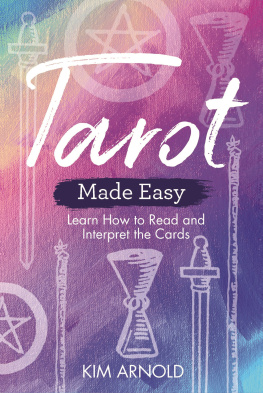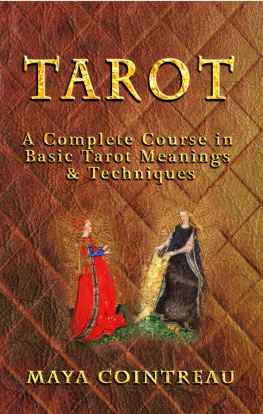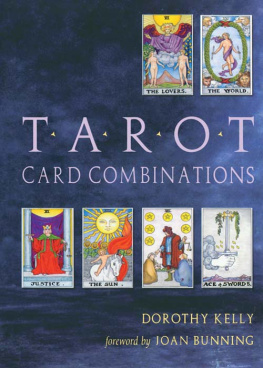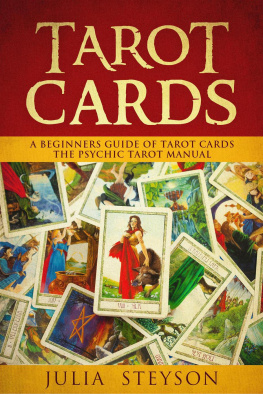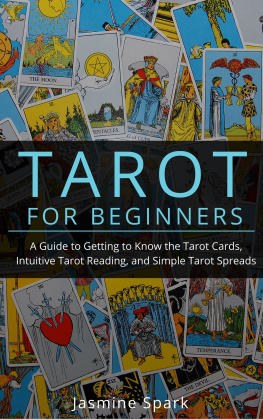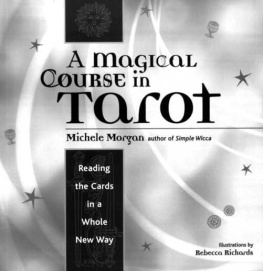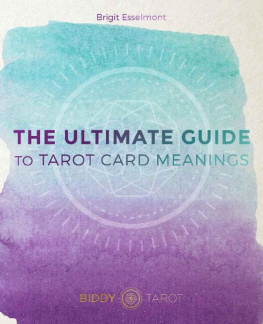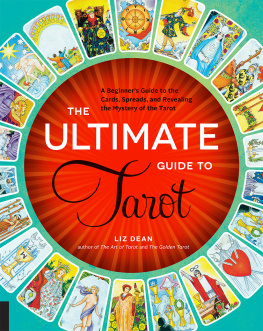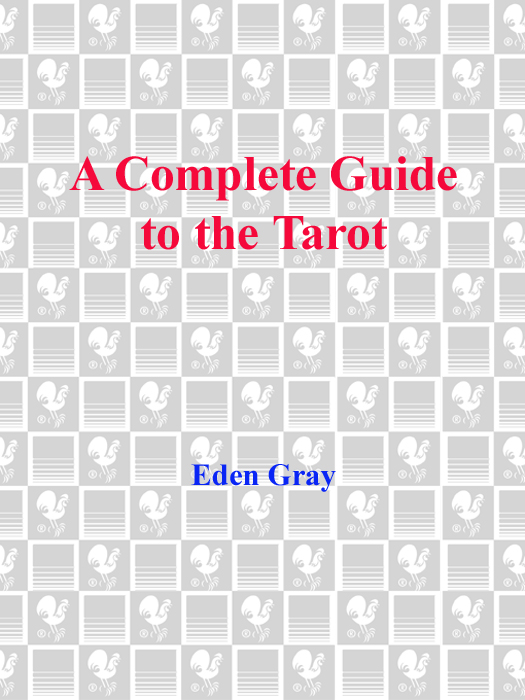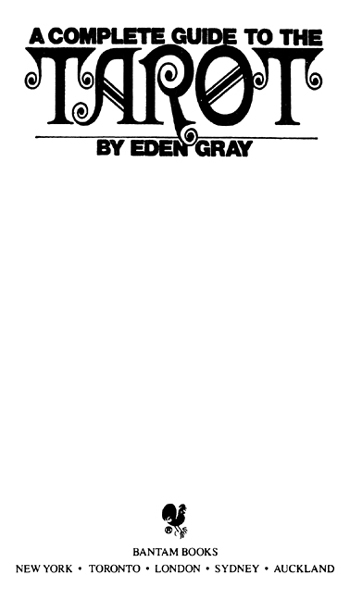THE MYSTERY OF THE TAROT
The origins of the Tarot are so veiled in the mists of time that it is only natural for myths and legends to surround it. Superstition, flights of fancy, and speculation have added their own patterns to the rich and colorful tapestry of Tarot lore and have only deepened its aura of magic and mystery. Cults have grown up around one or another historical theory, and sometimes their adherents have become fanatical in proclaiming the one and only truth. But the better-informed investigators retain a certain amount of flexibilityeven skepticismand make no ironclad assertions.
The truest claim we can make is that the Tarot is a symbolic record of human experience. Through deeply rooted mystic powers, the cards accomplish miracles of psychological insight, wise counsel and accurate divination.
Other Bantam Books of related interest
Ask your bookseller for the books you have missed
THE COMPLETE BOOK OF PALMISTRY
by Joyce Wilson
SOULMATES by Jess Stearn
A COMPLETE GUIDE TO THE TAROT
A Bantam Book / published by arrangement
with Crown Publishers, Inc.
PUBLISHING HISTORY
Crown edition published June 1970
Universe Book Club January 1971 Selection
Bantam edition / June 1972
All rights reserved.
Copyright 1970 by Eden Gray
No part of this book may be reproduced or transmitted in any form or by any means, electronic or mechanical, including photocopying, recording, or by any information storage and retrieval system, without permission in writing from the publisher.
For information address: Crown Publishers, Inc.
201 East 50th St., New York, N.Y. 10022.
eISBN: 978-0-307-77944-1
Bantam Books are published by Bantam Books, a division of Random House, Inc. Its trademark, consisting of the words Bantam Books and the portrayal of a rooster, is Registered in U.S. Patent and Trademark Office and in other countries. Marca Registrada. Random House, Inc., New York, New York.
v3.1
CONTENTS
ACKNOWLEDGMENTS
My deep appreciation to Nan Braymer for her invaluable assistance in the preparation of the manuscript of this book.
Also to Mary Beckwith Cohen for her advice on all matters that concerned Astrology.
1
THE TAROT DEFINED
The ancient and mystic pack of cards called the Tarot never fails to evoke the curiosity of the uninitiated. What are the Tarot cards? What makes them so different from our own playing cards? Can they really foretell the future? Can anyone learn how to read them?
This book is devoted to answering these and many other questions and to give the reader a knowledge of the Tarotits history, its links to other occult sciences, and the way it is used to shed light upon the past, the present, and the future.
Everyone agrees that modern playing cards are directly descended from one part of the Tarotthe resemblances between parent and child are too striking to be accidental. In both we find cards numbered one to ten, followed by pictures or court cards. And just as the Joker is unnumbered and has no assigned place in our deck, the Fool in the Tarot is also without a number of its own or a preordained positionyet both are ever present in their respective packs.
There are 78 cards in the Tarot, of which 56 (those most like modern cards) are equally divided among four suitsWands, Cups, Swords, Pentaclesanalogous to our Clubs, Hearts, Spades, and Diamonds. These suit cards are known as the Minor Arcana (arcana is the Latin word for secrets). They are followed by 22 cards called the Major Arcanacards that depict symbolic figures, elements in nature, the experiences of Man in his spiritual journey, his hopes and fears, his joys and sorrows.
The Major Arcana, as can be seen, bear little resemblance to modern cards. Their illustrations are drawn from the treasurehouse of universal symbols and images, from the legends, myths, philosophies, religions, and magic beliefs of the human race. Undoubtedly the wise men and seers through whom the Tarot is believed to have been transmitted over more than seven centuries were thoroughly versed in the astrological, numerological, and Kabalistic teachings of the ancients, and all these influences are reflected in the cards. The Tarot, nevertheless, remains a unique and independent discipline with its own divinatory powers and its own spiritual content.
Most of us are interested in character analysis, glimpses of the future, solutions to immediate dilemmasall of which we can seek in the Tarot. But there are also those who will value the Tarots help in meditation. The student of metaphysics gains remarkable insights into the inner meanings of the cards; the artist, constantly concerned with images and symbols, draws heightened creativity from contemplating the many-dimensional beauty of the cards; the Biblical student finds that the Tarot illuminates many passages in the Old and New Testaments. And since the Tarot is the key that unlocks the wisdom of the ancient philosophers, it reveals its most profound messages to the dedicated scholar and practitioner. (In this it is not unlike the ideographic writing of the Chinese, the hieroglyphics of the Egyptians, the picture writing of the Mayans.)
It is not necessary, however, to understand all the hidden secrets of the cards at firstor even secondglance. When the student is ready, the Tarot will begin to reveal its mysteries. And it is not imperative to believe in the cards for them to yield resultsyou dont have to take them on blind faith. Eventually you will tap the occult powers of the Tarot, and you will turn to it when dilemmas beset you.
If you consult an experienced Reader for help, you become what is called the Querent, with an unspoken question you want answered. After laying out the cards in accordance with one of the methods described in this book, the Reader will interpret what the cards are trying to tell you. But you yourself can learn the definitions of the symbols as given in the Glossary, as well as from the detailed descriptions and pictures of each of the cards in the body of the book. Then, after mastering one or another of the techniques for laying the cards out, you can before long try to read them. At first, of course, you will be turning back to the definitions again and again, but with persistence you will be rewarded.
The first Tarot cards were painted on parchment or thin sheets of ivory, silver, or even gold. The design for each card had to be drawn anew and colored by hand. Therefore the cards became the playthings of the nobles, who could afford to assign an artist to paint their own individual sets. Often the aristocracy had the Court cards drawn to resemble members of their own family or court.
Eventually, handmade cardboard became available, and then the designs were traced and painted with watercolors. Later still, in Nuremberg (about 1430), block printing was done from hand-carved wooden blocks. Thus some of the early cards are crude in design, and their details are often indistinct.
To reduce the cost of a Tarot deck, or perhaps because the Major Arcana were not used in the game of Tarroc, these 21 cards were dropped from the pack, as were the four Queens. At a later date, the Queens were evidently restored to some decks, and the Knights eliminated. Decks in this latter form are to this day used in the Spanish and Italian game of Tarroc. The cards from southern Germany developed a somewhat different patternbells for Pentacles, acorns for Swords, leaves for Wands, and hearts for Cups.


